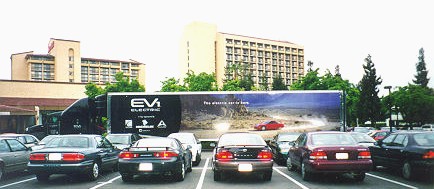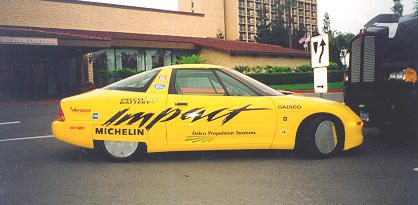EV1 Images, Santa Clara Marriott, August 1998

These images were from a press club meeting at the Santa Clara Marriott in August 1998. Previously the EV1 tour truck had been at local Saturn dealers making presentations to potential customers.
EV1 Prototype sets Land Speed Record for Electric Vehicles

On March 11, 1994 Lotus engineer Clive Roberts drove this yellow EV1 prototype to an electric vehicle land speed record of 183 MPH at Fort Stockton, Texas. Roberts was assigned by Lotus to GM's EV project, which is corporate speak meaning he/Lotus developed the suspension. (Clive now works for GM.) Modifications from a standard EV1 are relatively minor, having two more batteries, a slightly modified controller, an inch or two shorter ride height, special Michelin Pilot SX MXX3 tires in 205/50-R15 (a standard size), 3:1 final drive instead of 11:1, radio telemetry, racing seats, flush aluminum wheel covers, stripped interior and a roll cage. Note that the gearing change decreases the torque at the wheels, but increases top speed. Having a single speed transmission, the stock EV1 motor normally turns 13,000 RPM at 80 MPH.
One of the images below is a side view of the underside of the race car, beneath the passenger footwell and behind the front tires. The right front suspension can be seen at the right of the image. Presumably the bottom fairings were removed to disconnect the extra batteries which were in the footwell during the record runs. Not seen in the pictures below is an aproximately two foot tailcone added to further reduce drag. It's not clear if the tailcone was used in the record run.
Please see an extended conversation with Clive below the images.
Click on an image to see a larger view.
Some of the differences between street (red, left)
and race car (yellow, right) can be seen below:









The remaining images were for comparing the standard EV1 colors:
red, silver-blue and forest green.












